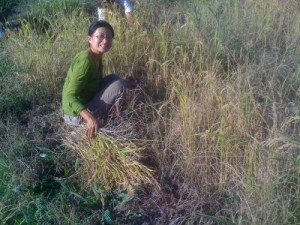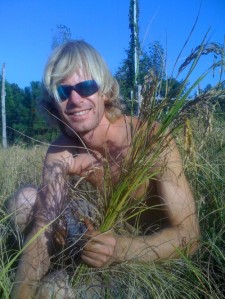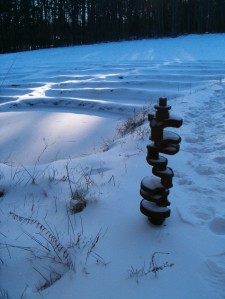 As hard as I’ve tried not to have expectations on this project, I’m happy to say that my expectations were exceeded the day I plucked a plump grain off a rice plant, popped it in my mouth and savored it’s sweet, tender taste. That was around September 25th. On September 28th and 29th, we harvested the entire plot by cutting the stalks just above ground level. We used harvesting clippers, which was a little tedious. Next year we hope to have scythes to make the task more efficient.
As hard as I’ve tried not to have expectations on this project, I’m happy to say that my expectations were exceeded the day I plucked a plump grain off a rice plant, popped it in my mouth and savored it’s sweet, tender taste. That was around September 25th. On September 28th and 29th, we harvested the entire plot by cutting the stalks just above ground level. We used harvesting clippers, which was a little tedious. Next year we hope to have scythes to make the task more efficient.
 Next we took the bundles of rice stalks to a covered shed and set up a threshing/winnowing station. We threshed the rice by beating the seed heads over a wire-mesh table. We removed the legs of the table on one side, which created a nice angle for us to thresh upon. After threshing all of the stalks from our 800 square foot rice padi, we winnowed the chafe from the grains using a fan. We ended up with about 20 pounds of rice with the hulls on.
Next we took the bundles of rice stalks to a covered shed and set up a threshing/winnowing station. We threshed the rice by beating the seed heads over a wire-mesh table. We removed the legs of the table on one side, which created a nice angle for us to thresh upon. After threshing all of the stalks from our 800 square foot rice padi, we winnowed the chafe from the grains using a fan. We ended up with about 20 pounds of rice with the hulls on.
Then came the stage that nearly did our project in: getting the hulls off the rice grains. Each grain has a tight, tough casing on it that you could eat, but it isn’t particularly pleasant. We experimented with a variety of low-tech methods to get the hulls off. I tried rubbing them through a wire mesh screen…didn’t really work. I built a contraption out of a barrel with a wire mesh screen set inside the center of the barrel lengthwise, with rice seeds inside and the lid on. We rolled that barrel all over the place…that really didn’t work. Then I tried to convert a coffee bean grinder into a mini-rice huller by squeezing pen caps over the the metal blades. The pen caps got obliterated as did the rice grains, but the rice hulls did come off! Unfortunately my tiny portion of powdery rice chunks didn’t impress Haruka in the least, and it was back to the drawing board. The traditional mortar and pestle method turned out to work the best, but it still crushed a lot of the grains and it didn’t have the efficiency we were looking for.
 That was early October. Four months ago. Most of our rice just sat in bags with the hulls on, waiting for a miracle. A glimmer of hope came in November when we applied for the RAFI Tobacco Communities Reinvestment Fund grant. Our proposal for the $10,000 grant asked for funding to aid us in growing a 1 acre rice plot. This included funding for a rice-hulling machine, seeds, harvesting tools and labor to build rice terraces and a rainwater-catchment pond.
That was early October. Four months ago. Most of our rice just sat in bags with the hulls on, waiting for a miracle. A glimmer of hope came in November when we applied for the RAFI Tobacco Communities Reinvestment Fund grant. Our proposal for the $10,000 grant asked for funding to aid us in growing a 1 acre rice plot. This included funding for a rice-hulling machine, seeds, harvesting tools and labor to build rice terraces and a rainwater-catchment pond.

Then came the long wait. A wait in which I apparently felt no motivation to write a third installment on our rice project blog. Thought about it a few times, but…nope, nothing. Then came the call from RAFI 2 days ago. The grant came through, and just like that, we’re back on track for producing rice in earnest here in Chatham county.
Thank you RAFI and thanks to all of you for the immense support you’ve given us! Rice is on the way !
I’m so glad you got your grant! I’m looking forward to trying some locally grown rice!!!
LikeLike
We are sooo very excited about LOCAL rice! Keep up the good farming, EdibleEarthscapes!
LikeLike
Thanks Mary! We are excited too! Stay tuned on our progress!
LikeLike
Congratulations on seeing it through! You two are mighty entrepreneurial! We’re going to have a new Chatham breed of rice…I look forward to whatever name you choose for the new variety(s).
LikeLike
Hey, enjoyed reading about your adventures with rice. Will come by for crop mob tomorrow to help out.
Some places in the SC lowcountry where I come from have resurrected an heirloom variety of rice called Carolina Gold. Lots of interest in rice and other southern grains right now.
Frank
LikeLike
just curious, what did you guys do with the rice hulls? of course everyone here uses it for mulch, but we’re going to stuff it in bags and use it to insulate the house we’re building.
LikeLike
Hi Anna,
We are planning to use the rice hulls for mulch as well as it is suggested in fukuoka’s book but that is a great idea to use it as insulation! We are planning on building our own home someday soon so would love to hear how that turns out! Keep us posted!
LikeLike
just finished reading about your adventures in rice. you’re the first I’ve heard of doing in by-hand in the states. awesome! i’ll be following your progress and hopefully learning a few things along the way.
my wife and i live in kyushu now and have been growing things for about a year now. fukuoka is also an inspiration for us, though his methods have so far proved difficult to duplicate. last year i was able to get some of the dryland rice he developed from a group in kyoto. most of it was lost in the weeds but we’ll try again this year in some actual paddies.
some day we also may move back to the states and continue farming. good luck with everything!!
LikeLike
Thanks for reading about our rice project. I think the flooding helps to cut down on weeds. We started weeding half the experimental plot last year and then decided to leave the other half the way it was just to see what happened and we still had similar results. Digging actual paddies, flooding it once, laying down compost helps to suppress weeds. I hope you have more success this year. I haven’t had a chance to visit Kyushu yet, but would love to go to all the onsens and eat the food! Where in Kyushu are you?
LikeLike
yes, growing rice in a field is much harder than a tambo. especially with all the weeds we get here in Miyazaki. we battled for weeks trying to protect those rice seedlings before giving up. we got just one little bushel of rice. so sad. looking at your farm photos my wife and i were impressed with your lack of weeds! how do you do it??
we have some tambos in nearby mountains and last year grew the local standard, hinohikari. this year we’ll do the same but with additional tambos of the fukuoka rice and a basmati/japanese hybrid. did you turn your field before you planted the rice last year? everyone here plows first then floods but this year we’re not using a plow….and turning the tambos (that have hardened since last year) by hand seems like a tremendous amount of work!
what part of japan where you guys in? it’s been great to read about the workings of your farm. your philosophy and methods are right in line with ours and it’s inspiring to see your success!
LikeLike
Hi,
I am looking for happy hill rice seed or some seed that will be happy growing on dry land without the paddy environment. I have not found parts 1 or 1 of your growing rice in NC so I don’t know if they contain information regarding sourcing of rice seed. Any helpful information will be greatly appreciated. All my best, Michael
PS I have a small farm in WNC near Max Patch which is 12 miles west of Hot Springs and only 3 miles from the TN border. M
LikeLike
Hi Michael,
If you click Growing Rice on the side bar under Categories, you can find all entries related to growing rice. We got our seed from Kitazawa Seed Company based in California. It is a premium sushi rice so I don’t know how well it would do on dry land but you could give it a try?
LikeLike